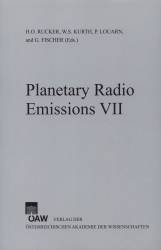
Planetary Radio Emissions VII, pp. 231-240, 2011/12/28
Proceedings of the 7th International Workshop on Planetary, Solar and Heliospheric Radio Emissions held at Graz, Austria, September 15–17, 2010

In the present paper, radio observations made at the wavelength of 6 cm with the VLA in 2009 are analyzed. Reconstructed images of the brightness distribution show significant intensity variations of the equatorial peak emissions on both sides of the planet. The fluctuations are characterized by asymmetrical changes in the brightness distributions. The contribution of a comet-like impact to the observed variations is discussed. During the third week of July, ground-based measurements at different radio bands confirmed that a large projectile had struck Jupiter’s atmosphere. The examination of the 2009 VLA data sets shows that the steep enhancement of the emission radiated by Jupiter’s electron belt occurred during the same period. The increase in the synchrotron radiation was observed to go on for a couple of weeks before gradually fading in August. Two-dimensional reconstructions of the equatorial brightness distribution demonstrate that the time variability of the radio emission during the middle of 2009 was driven by the longitudinal expansion of an impact-related synchrotron “hot spot” originally located at the Jupiter System III longitude of 305 degrees.